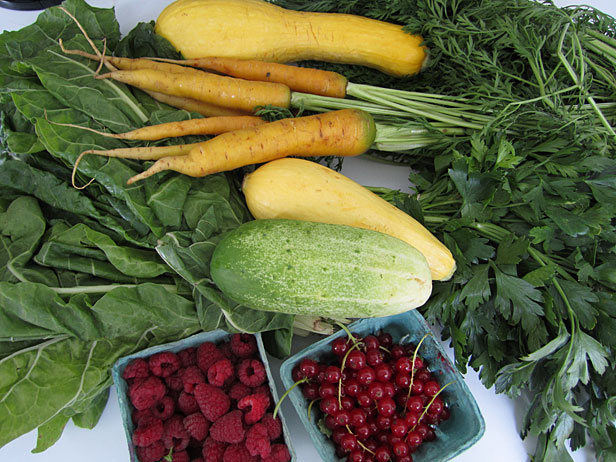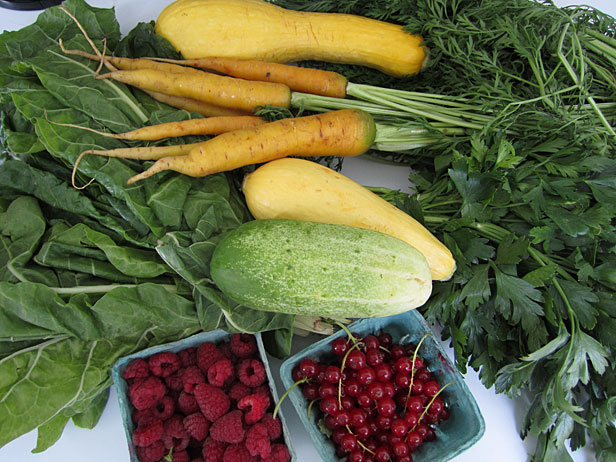 The bounty of week 8. (Jennifer Prediger)
The bounty of week 8. (Jennifer Prediger)
It’s Week Eight of a takeout eater’s journey into the realm of Community Supported Agriculture. I’m learning how to cook actual food and writing about it in this Urbivore’s Dilemma series. Eight weeks down. Twenty-one more to go.
Last week, I asked for your ideas for how to share the kitchen with the ones you love. I tried to incorporate your suggestions when cooking this week’s CSA box, which was comprised of carrots, cucumber, currants, raspberries, Italian parsley, summer squash, and a dark and mysterious leafy green.
Variations on the theme of “division of labor” are central to harmonious shared cooking experiences, it seems. This week, I had intentions of cooking in tandem and having fun. But when squash came to shove, I wanted to be in the kitchen alone.
I find the time in there very meditative. The tactile nature of cutting vegetables is soothing as you pay attention to yourself and the food being prepared. My would-be fellow chef washed the dishes.
This particular meal needed a Coldplay soundtrack, as “it was all yellow“: polenta, crookneck squash, braised carrots, and ginger.
I cut up a delightfully yellow summer crookneck squash. Cooked in cast iron with olive oil, salt, the scallions, a garlic scape, and parsley to garnish, the squash was light, savory, and delicious. Being a summer squash, it’s apparently less nutrient-rich than a squash harvested in fall. But unlike winter squash such as butternut, there’s no need to peel it — and anyway the peel is where most of summer squash’s nutrients are stored.
Cutting the carrots from their leaves, I wondered what one does with carrot greens? I tasted a bite and it proved to more or less taste like a carrot, in leaf form. Not knowing what to do with them, I put them in the ever-blossoming bag of “compost” in the freezer. (More on that soon!) I braised the carrots were braised with olive oil and ginger, and pan-fried some polenta.
This meal taught me something interesting: food that grows in a season actually pairs well with the season itself. Straight out of the ground, this meal was light and perfect for a hot summer day. How smart the soil is! Eating the carrots, I even had a small yearning for the root vegetables of the fall. It occurred to me that eating seasonal food perhaps puts us into a different culinary circadian rhythm, making us want to eat more seasonal food.
We’ll see how I feel about that after eating root vegetables for six colder months. For now, I’ll enjoy this romantic notion and the food on the plate.
How has seasonal eating affected your palate? Do you look forward to the foods in other seasons? Even in the cold season?
Next week, my CSA box will have lettuce, radicchio, beets, scallions, summer squash, cukes, cilantro or mint, and sweet peppers! And what on earth do you do with radicchio? Readers, your thoughts and tips are what make writing this interesting. Thank you for the ongoing conversation.




